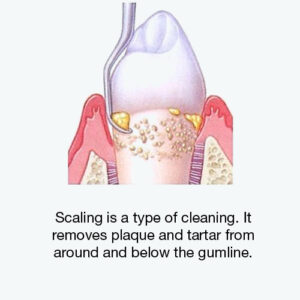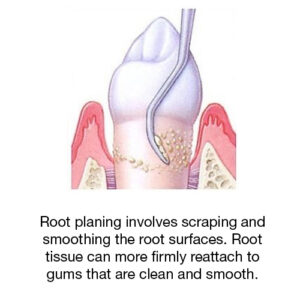Scaling and Root Planing removes the calcified irritants under the gums thus reducing inflammation and infection.
Over time, plaque combines with natural minerals in the mouth forming calculus (tartar). These hard concretions adhere to the teeth and form a rough surface on the teeth and roots, allowing for even more plaque accumulation. Calculus by itself does not cause the deterioration of the periodontal attachment. Rather, it serves as a substrate for the further colonization of bacterial plaque on the irregular root surfaces. The bacteria initiate and perpetuate the inflammatory process that causes periodontal disease.
After x-rays, a clinical exam, periodontal charting and patient education, scaling and root planing can be the first treatment for periodontal disease. This procedure serves to remove the calcified irritants under the gums thereby reducing inflammation and infection.
 Scaling
Scaling
One-fourth or half of the mouth is anesthetized so that the hygienist can comfortably scrape below the gums. This is called scaling and it’s similar to removing the scales from a fish. The procedure may be performed by a dentist, hygienist or periodontist (gum specialist), using hand instruments or ultrasonic vibrating instruments to blast deposits off the teeth
 Root Planing
Root Planing
Scaling alone may leave a rough surface, so it is usually combined with root planing. Just as a carpenter planes a door to make it smooth, the hygienist carefully planes the root surfaces to make them free of calculus. Smooth root surfaces allow the gums to regenerate without irritation. The gum tissue shrinks and tightens around the teeth because the irritant has been reduced or eliminated.
Charting
After scaling and root planing is completed and the soft tissues have healed, the status of periodontal health is determined by another charting of pocket depth. The ultimate goal is a shallow valley around the teeth with a depth of 1 to 3 mm.
For many patients, scaling and root planing is the only treatment needed. It can often eliminate the inflammation and infection that promotes the tissue destruction around teeth from periodontal disease. Most effective in treating early periodontal disease, this non-surgical approach is well-received among dental patients. Unfortunately, scaling and root planing alone is not a cure for periodontal disease. It must be followed by an ongoing process of good dental hygiene and regular professional care.

